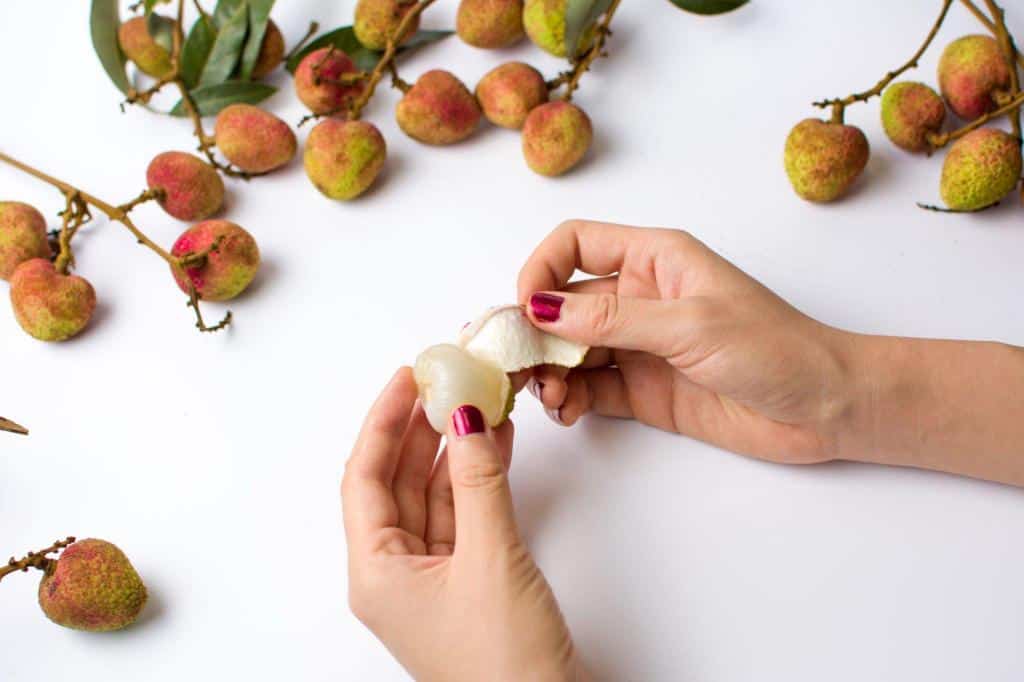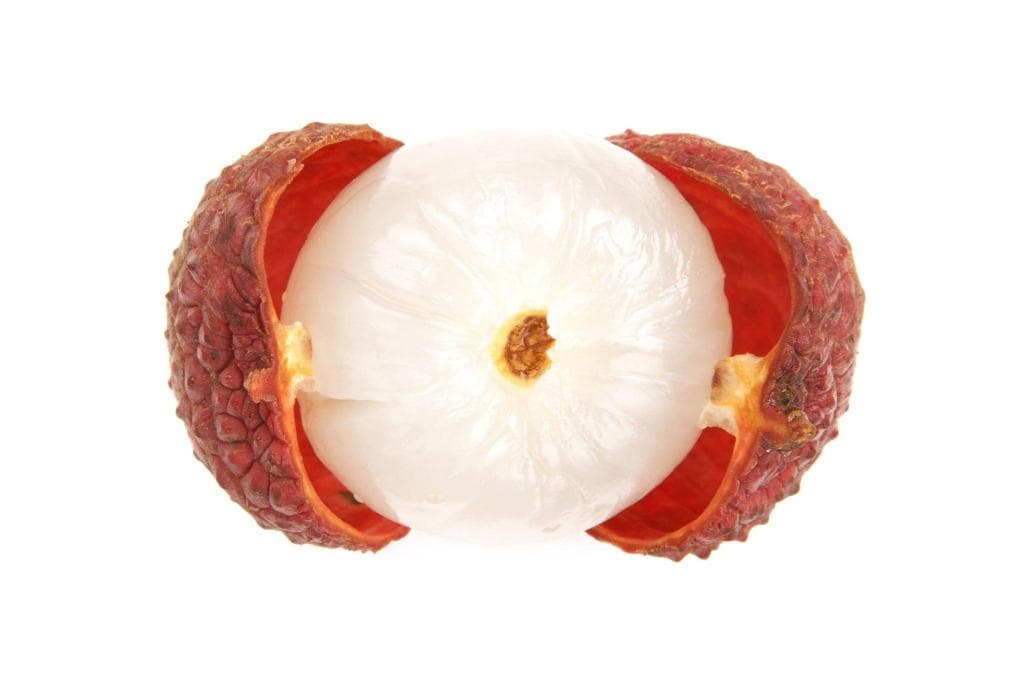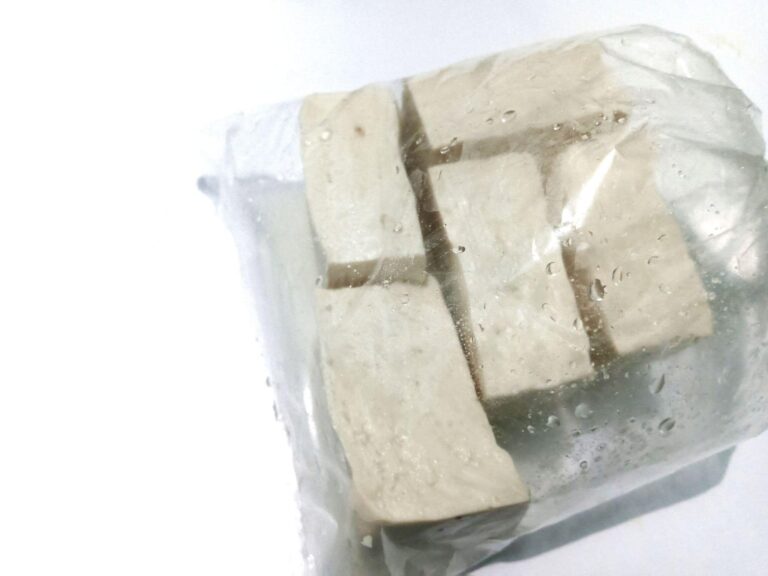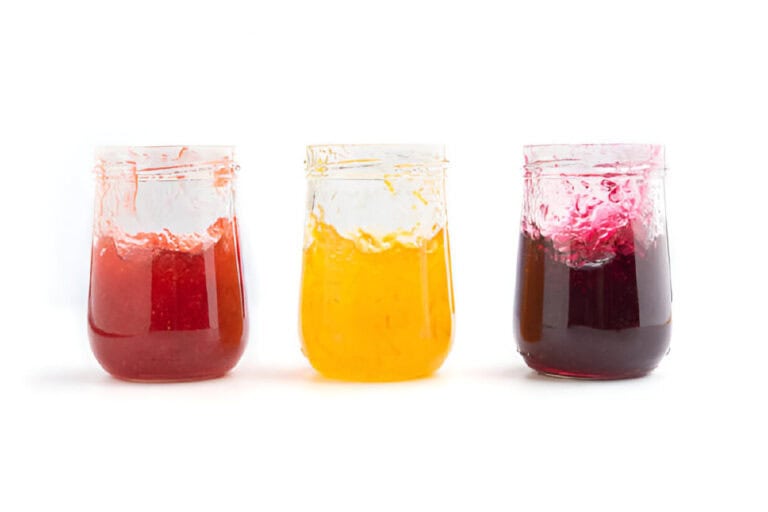Can You Eat Lychee Skin? Is Lychee Skin Poisonous or Safe to Eat?

When you think of lychee, the first thing that comes to mind might be its juicy, sweet flesh. The lychee, a jewel-toned orb with a rugged exterior, has long captured the attention of adventurers and curious minds alike. But here’s the twist – beyond the luscious flesh lies an enigma: the lychee skin. Can you eat lychee skin as a culinary companion or a treacherous foe?
Lychee skin can be eaten as a culinary companion and is safe to consume. The skin is edible and can be peeled back to reveal the fleshy white fruit inside, which is fragrant and delicious
Brace yourself for a journey through flavor, nutrition, and unconventional feasting. n this article, we delve into the world of lychee skin – its nutritional value, edibility, potential health benefits, and possible risks.
We’re about to uncover the truth, navigating the fine line between indulgence and caution, as we uncover whether this exotic gem’s outer coat is a gatekeeper to delight or a hazard to avoid. So, fellow food adventurers, let’s embark on this intriguing expedition into the world of lychee consumption – skin and all.
Introduction to Lychee and Its Skin
Lychee, scientifically known as Litchi chinensis, is a tropical fruit beloved for its refreshing taste and vibrant aroma. Lychee is a tropical fruit native to South China, Malaysia, and northern Vietnam.
The fruit is small, about 3.0-5.0 cm in diameter, and varies in shape from round to egg or heart-shaped. This small, round fruit has a rough, textured skin that is often peeled away before indulging in its succulent flesh. But what about that skin? Is it more than just a protective layer?
The skin color is bright red, dull red, purple-red, or pale dull yellow with dark raised specks. Due to the presence of anthocyanins, the skin is tough, corky, and thin and covered by a pericarp that resembles pink or red leather. The aril, which envelops a big seed, is whitish, translucent, sweet, and, in good quality, juicy.
Lychee’s bark is gray-black, and the branches are brownish-red. Its evergreen leaves are 12.5 to 20 cm long, with leaflets in two to four pairs. Some 200 cultivars exist, with varying fruit quality, size, and color.
Can You Eat Lychee Skin? Poisonous or Safe?

Llychee skin is generally safe for consumption. Unlike some fruits with inedible peels that harbor bitter compounds or toxins, lychee skin doesn’t pose such risks. In fact, the skin contains certain beneficial compounds like antioxidants and fiber, which contribute to its nutritional value.
When considering whether to indulge in the skin, texture and flavor play a pivotal role. Lychee skin, while slightly chewy, is not overly tough or unpleasant. Its taste is milder compared to the intensely sweet flesh, with a hint of earthiness that can be surprisingly enjoyable.
Lychee skin, being fibrous, might require a bit more chewing than the tender interior, but it’s not a challenge for most people. The skin’s digestibility is akin to that of many other fruit skins—completely manageable.
As with any food, personal preferences come into play. Some individuals relish the contrast of flavors and textures between the skin and the fruit, while others might find it less appealing. Ultimately, whether to eat the skin or not depends on your culinary adventurousness.
Nutritional Composition of Lychee Skin
Lychee skin is not just a cover; it houses a range of nutritional components that might surprise you. Under the surface, you’ll find nutrients like antioxidants, vitamins, and fiber. While the majority of people focus on the inner goodness, there’s something intriguing about exploring the potential benefits of the outer layer.
If you’re contemplating incorporating lychee skin into your diet, understanding its nutritional profile can be beneficial. The skin contains:
| Nutrient | Quantity per 100g |
| Fiber | 1.3g |
| Vitamin C | 136% of the DV |
| Antioxidants | Various |
| B Vitamins | Trace amounts |
These values emphasize that lychee skin, while not a powerhouse of nutrients, can still offer a modest dose of dietary fiber and a significant vitamin C boost, contributing to overall health and well-being.
Health Benefits of Consuming Lychee Skin
Now, let’s talk about the potential perks of indulging in lychee skin. Beyond its taste, the skin offers a dose of antioxidants that can contribute to your overall well-being. Antioxidants play a role in combating harmful free radicals in the body. Additionally, the skin contains dietary fiber, which is known to support healthy digestion.
Lychee skin offers several health benefits, including:
- Anti-aging: Lychee skin contains oligonol, a polyphenol high in antioxidants that helps protect the skin from oxidative stress and reduces the appearance of fine lines and wrinkles.
- Promotes skin health: Lychee skin is rich in vitamins and antioxidants that help boost circulation, promote the synthesis of new skin cells, and improve skin tone and texture.
- UV protection: Consuming lychees can help prevent sunburn and protect the skin from UV rays due to their high vitamin C content. Anticancer effect: Lychees contain flavonoids and other phytonutrients that have been shown to have anticancer properties.
- Cardiovascular health: Lychees are rich in potassium, which helps regulate blood pressure and improve cardiovascular health.
Overall, consuming lychee skin can provide several health benefits, especially for the skin. However, it is important to note that some people may be allergic to lychee fruit, and excessive consumption may cause hypoglycemia in undernourished individuals.
Potential Risks and Concerns of Eating Lychee Skin
As with many things, there are pros and cons to consider. When it comes to lychee skin, one must be cautious about potential risks.
While lychee skin offers several health benefits, there are also some potential risks and concerns associated with consuming it. These include:
- Toxicity: Naturally occurring toxins in lychee fruit have been linked to toxicity that leads to fever, convulsions, and seizures. Additionally, lychee seeds contain potent toxic substances called hypoglycin A and methylene cyclopropyl-glycine (MCPG), which can result in hypoglycemic encephalopathy, a coma brought on by extremely low blood sugar..
- Allergic reactions: Some people may be allergic to lychee fruit, which can cause symptoms such as itching, swelling, and difficulty breathing.
- Pesticide residues: Lychee fruit is often treated with pesticides, which can leave residues on the skin. It is important to wash lychee fruit thoroughly before consuming it to reduce the risk of pesticide exposure.
- Short shelf life: Lychee fruit has a short shelf life and can spoil quickly, which can lead to foodborne illness if consumed after it has gone bad.
Overall, while lychee skin can provide several health benefits, it is important to be aware of the potential risks and concerns associated with consuming it. It is recommended to consume lychee fruit in moderation and to wash it thoroughly before eating it. Additionally, it is important to avoid eating unripe lychee fruit and the seeds, which can be toxic.
Culinary Creativity with Lychee Skin
Beyond its conventional role as a protective layer, lychee skin holds potential in the culinary world. Innovators have explored ways to incorporate this often-overlooked part of the fruit into recipes and dishes that tantalize the taste buds.
- Lychee Skin Infusions: The tough, textured skin can infuse your beverages with a burst of exotic flavor. Drop a few lychee skins into your water, tea, or even cocktails for a subtle fruity essence that elevates your drinks to a new level.
- Lychee Skin Syrup: Boil lychee skins with sugar and water to create a fragrant syrup. This syrup can be drizzled over desserts, pancakes, or used as a sweetener in various recipes, adding a hint of lychee’s unique aroma to your culinary creations.
- Lychee Skin Chutney: Blend lychee skins with spices, vinegar, and sugar to whip up a zesty chutney. This condiment pairs wonderfully with grilled meats, seafood, or even as a dipping sauce for spring rolls, delivering a delightful balance of sweet and tangy flavors.
- Lychee Skin Sorbet: Freeze lychee skin puree with a touch of sugar for a refreshing sorbet. This icy treat is a perfect palate cleanser or a guilt-free dessert option for those seeking a taste of the tropics.
- Lychee Skin Garnish: Thinly slice lychee skins to create a striking garnish for your dishes. Whether adorning salads, sushi rolls, or desserts, these vibrant and aromatic strips add a touch of elegance and flavor.
From jams, syrups, and sauces to infusions in beverages, lychee skin can lend a unique flavor and aroma to various creations.
Myths and Facts About Eating Lychee Skin
Misinformation often surrounds unconventional food practices, and lychee skin consumption is no exception. It’s essential to discern between myths and facts.
- Myth: Lychee skin is toxic and should not be consumed.
Fact: Lychee skin is safe to eat and offers several health benefits, including anti-aging, promoting skin health, UV protection, an anticancer effect, and cardiovascular health.
- Myth: Lychee skin is difficult to digest and can cause digestive problems.
Fact: Most people can easily digest lychee skin and it is edible. However, some people may experience digestive problems if they consume too much lychee fruit, especially if it is not ripe.
- Myth: Lychee skin is not good for the skin and can cause skin irritation.
Fact: Lychee skin is rich in vitamins and antioxidants that help boost circulation, promote the synthesis of new skin cells, and improve skin tone and texture. It is safe to use on the skin and can help prevent sunburn and protect the skin from UV rays.
- Myth: Lychee skin is high in pesticides and should not be consumed.
Fact: Lychee fruit is often treated with pesticides, which can leave residues on the skin. It is important to wash lychee fruit thoroughly before consuming it to reduce the risk of pesticide exposure.
Overall, lychee skin is safe to eat and offers several health benefits. However, it is important to consume lychee fruit in moderation and to wash it thoroughly before eating it. Additionally, it is important to avoid eating unripe lychee fruit and the seeds, which can be toxic
In Conclusion
Is lychee skin safe to ingest? In the grand culinary adventure that is lychee consumption, the skin offers an opportunity for exploration. It’s a matter of personal choice, tolerance, and even cultural influences. With proper consideration of its nutritional value, potential risks, and culinary possibilities, you can make an informed decision about whether to venture beyond the familiar world of lychee flesh.
Eating lychee skin benefits those who seek to expand their palate. The verdict? It’s safe to eat, delivering a modest nutritional contribution while providing an interesting contrast to the juicy flesh. It can be a rewarding journey to fully explore the lychee, whether you are interested in its health advantages or cultural significance.
Whether you choose to embrace this aspect of the fruit or stick to the tried-and-true flesh-only approach, the decision is yours. As with many gastronomic choices, personal taste and curiosity should guide your path, so why not give lychee skin a chance to tantalize your taste buds? Including lychee peel in your diet can be a safe and enjoyable experience, adding a layer of complexity to your culinary repertoire.






